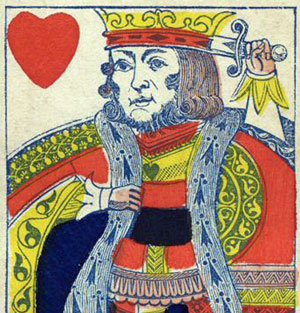Suicide King
The King of Hearts, holding a sword behind his head, is sometimes nicknamed the “Suicide King”. He can be seen to derive from a late medieval design showing a King wielding a battle axe.

The Origin of the “Suicide King”
The “Suicide” King of Hearts derives from a medieval design showing a King wielding a battle axe
Many fanciful theories have been proposed regarding the origins of the court figures on our standard English playing cards. The fifteenth century cards of Pierre Marechal of Rouen, with their air of self-assurance, are the predecessors of our contemporary standard Anglo-American court cards which are now recognised world-wide. The early history of the development of different regional patterns is not always straightforward, so that as card makers migrated or copied each other, certain figures reoccur in patterns from other countries, even with different suit systems.
The King of Hearts, holding a sword behind his head, is sometimes nicknamed the “Suicide King”. He can be seen to derive from a late medieval design showing a King wielding a battle axe. All the important features can easily be recognised: the belt, the patterned cloak held by his hand and the stance showing one leg - except in the double-ended version. Sometimes cards were turned to face the other direction, but by around 1870 English cards were fixed with the suit symbol accommodated at the left-hand side to assist in fanning, or “squeezing” the cards in hand.

Above: eight versions of the 'battle axe' king from various periods and locations, illustrating how the King of Hearts in modern standard playing cards derives from a late-medieval design. Top Row (left to right): 1) fifteenth century French. 2) Anglo-French, late 15th/early 16th century. 3) Spanish 16th century. 4) French 17th/18th century. Bottom Row: English cards from 17th century to late 19th century.
By around 1800 the battle axe seems to have been replaced by a sword which disappears behind the King's head. Curiously, in the double-ended version, the King of Hearts becomes the only four-handed court card.
A similar late medieval derivation can be shown for the remaining court cards in the English pack. Many of the attributes, or symbols of office, have changed or become unrecognisable over the years, but the basic features are still there. The question of whether they were facing left, right or straight forwards seems to be simply a matter of chance.
See also: Pierre Marechal of Rouen • Early Anglo-French cards • Phelippe Ayet, c.1574 • Provence pattern • 17th Century Spanish cards from Navarra • Joan Barbot, San Sebastian, c.1765 • Blanchard, c.1770
Update - the “Suicide King” today
Many new decks have fully custom court designs. However, the “Suicide King” is nearly always there.

Above: five examples of the “Suicide King” from contemporary decks, 2020s.
An interesting observation

Above is a screenshot from the Clint Eastwood film “For a Few Dollars More” (set in 1872 and filmed in 1967, mostly in Spain). The cards in the film are not consistent with 1872 period, and are merely 'modern' cards from the 1970s manufactured in Spain by Naipes Fournier. The “Suicide King” (King of hearts) with Jumbo indices is shown in play (cards in the 1870s had no indices). Thanks to Jay Holtslander for spotting this.
• The Man With No Name Costume Information►
The king holds his sword in his left hand, but a second left hand is also holding his coat. This idiosyncrasy is found only in Fournier's design.

By Simon Wintle
Member since February 01, 1996
Founder and editor of the World of Playing Cards since 1996. He is a former committee member of the IPCS and was graphics editor of The Playing-Card journal for many years. He has lived at various times in Chile, England and Wales and is currently living in Extremadura, Spain. Simon's first limited edition pack of playing cards was a replica of a seventeenth century traditional English pack, which he produced from woodblocks and stencils.
Related Articles

Victorian grocer’s scale plate
Large flat plate decorated with highly coloured English cards and royal arms.

Queen of Arts
A wide variety of women artists celebrated on cards with illustrations by Laura Callaghan.

The Glasgow Pack
Issued to celebrate Glasgow’s reign as European City of Culture in 1990, with city views and works o...

Cathedrals, Abbeys & Minsters playing cards
54 pictures of different famous cathedrals, abbeys and minsters in England and Wales.

Christmas Carols
Christmas Carols playing cards illustrated by Stuart Dilks

Pam is the Knave of Clubs
Playing cards as metaphors in 18th century art - from fate, chance and social hierarchy t...

Question and Answer Games
A card game called “Impertinent Questions and Pertinent Answers” was launched in the early 1920s by ...

Dr Sacheverell
Dr. Henry Sacheverell's impeachment in 1710 sparked widespread public unrest and political upheaval,...

Leadmill playing cards
Promotional pack for an arts centre in Sheffield with designs by Martin F. Bedford.

Agatha Christie and card games
Agatha Christie uses card-play as a primary focus of a story, and as a way of creating plots and mot...

English Heritage
52 different colour photos of historic sites managed by English Heritage.

Il Tarocco Mitologico
Fully pictorial Tarot designed by Amerigo Folchi with figures mainly from Greek mythology.

The Malt Whiskies of Scotland
Three packs featuring photographs by Duncan McEwan of malt whisky distilleries in Scotland.

Typographic Playing Cards
Typographic Playing Cards designed by Jim Sutherland, c.2010.

76: Transitions: Hunt & Sons
Styles change and technology develops. This means that it's possible to see transition periods in th...

Gibson’s History of England
History without tears for young and old, 1920s.
Trending Articles
Popular articles from the past 28 days




